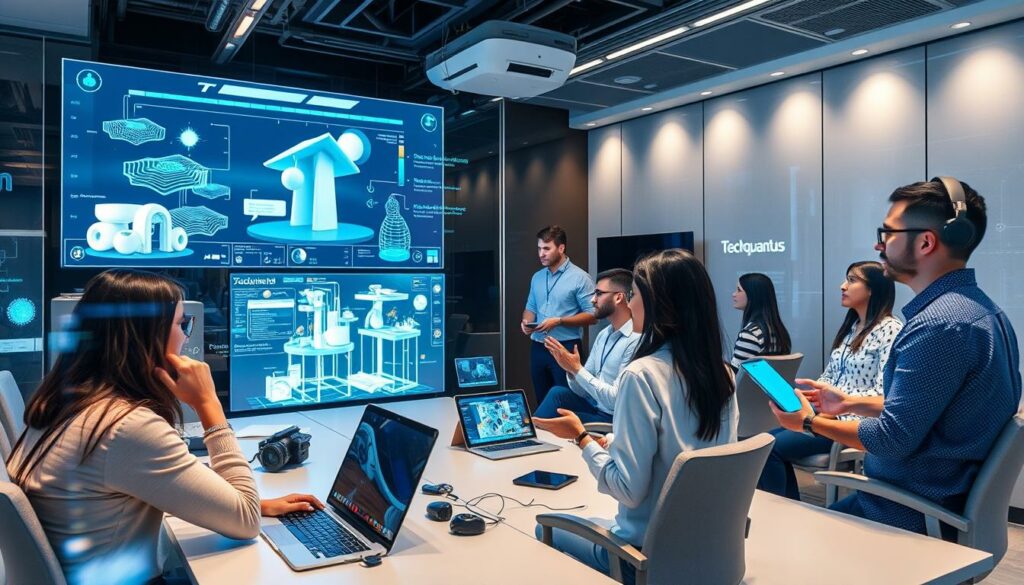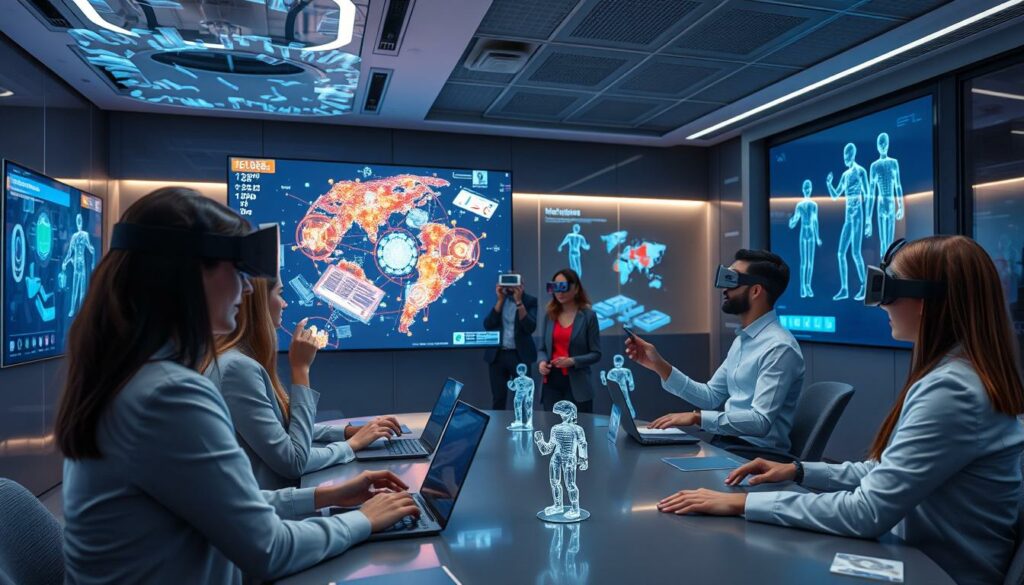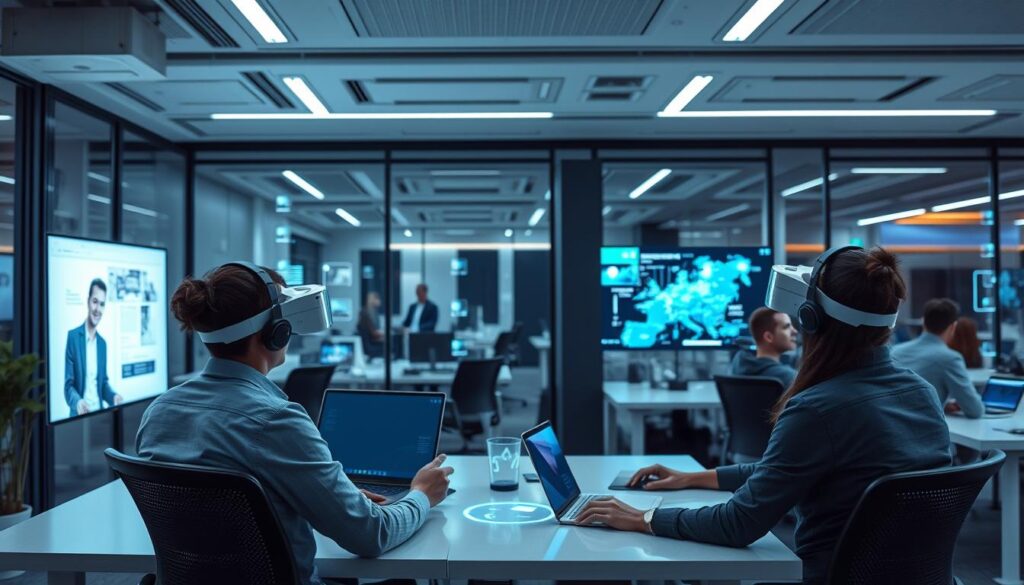Did you know 72% of professionals worldwide feel more confident with Extended Reality (XR) at work? This boost in confidence shows how XR is changing business training in the US, India, and the UK. Companies are now using virtual reality (VR), augmented reality (AR), and mixed reality (MR) in their training. This article will show you how XR makes training more engaging, helping organizations improve learning and employee involvement.
The future of business training looks bright, with XR set to grow despite challenges. The State of XR 2024 report says the industry will face economic issues and competition. But it will also benefit from AI and machine learning. Get ready to learn about XR technology in business training.
Key Takeaways
- 72% of professionals feel more confident using XR technologies.
- As businesses embrace XR, learning retention improves significantly.
- AI and machine learning are leading opportunities within the XR market.
- Economic headwinds remain a primary challenge for many organizations.
- VR, AR, and MR can create effective immersive training environments.
- The 3D geospatial market is projected to reach $16.2 billion by 2030.
Understanding Extended Reality (XR) and Its Components
Extended Reality (XR) technology combines the physical and digital worlds. It includes virtual reality, augmented reality, and mixed reality. These components show XR’s potential in business training.
Virtual Reality (VR) takes users into digital worlds. It lets them experience things that are hard or impossible in real life. Companies using VR for training see big improvements, with 25% of US, 19% of Indian, and 16% of UK professionals adopting it.
Augmented Reality (AR) adds digital info to the real world. It makes learning more interactive by combining digital and physical elements. This makes learning richer and more engaging.
Mixed Reality (MR) mixes VR and AR. It lets users interact with digital objects in real space. This creates a unique training environment that boosts collaboration and engagement.
Recent studies show 72% of professionals feel more confident with XR in their work. Yet, economic challenges and finding new customers are big hurdles. Still, 88% of experts see big opportunities in AI, machine learning, IoT, and wearable tech. For more on XR, check out this link.
Benefits of Using XR in Business Training
Businesses are seeing the benefits of XR for training. This tech includes VR, AR, and MR, offering solutions for different needs. It helps in better learning retention by making training more real.
Using XR boosts employee engagement. It makes training more fun and interactive. This leads to better motivation and performance. Plus, XR lets businesses tailor training to fit their goals.
XR also helps in learning practical skills. For example, healthcare uses it for better surgery monitoring. Retail uses it for immersive shopping, improving both customer satisfaction and employee training. It saves money by cutting down on travel and resource costs.
| Benefit | Description |
|---|---|
| Enhanced Learning Retention | Immersive experiences promote deeper understanding of training material. |
| Increased Employee Engagement | Interactive elements keep employees involved and motivated. |
| Simulated Real-World Scenarios | Allows practice of practical skills in a risk-free environment. |
| Cost-Efficiency | Reduces travel and material expenses, scaling training solutions effectively. |
| Industry Adaptability | Applicable across various sectors for tailored training approaches. |
Looking ahead, using XR in training can change the game. It’s a smart move for improving your workforce.
How XR Enhances Immersive Training Experiences
Extended Reality (XR) is changing how we train in many fields. It uses Virtual Reality (VR) and Augmented Reality (AR) to make learning fun and effective. This boosts employee skills and confidence.
Virtual Reality (VR) in Training Programs
VR training lets people practice in real-like scenarios. It’s great for fields like healthcare and aviation. Trainees can try out skills in safe, virtual environments.
This approach has shown a 72% boost in business confidence. It proves how powerful these training tools can be.
Augmented Reality (AR) for Skill Development
AR helps develop skills by adding digital guides to real-world tasks. It makes learning complex things easier. Companies like Taqtile are at the forefront of using AR in training.
They work with Hololight to make AR tools more accessible. This opens up new training chances for industries like airlines and the military. The 3D geospatial market is expected to grow to $16.2 billion by 2030.
XR is getting better fast, with more focus on AR and MR. Companies like Meta and HTC VIVE are leading the way. They show the bright future of immersive training.
By using these new technologies, companies can face economic challenges head-on. They can also get their teams ready for today’s business needs. For more on XR trends, check out XR trends in today’s market.
The Role of Mixed Reality (MR) in Workforce Training
Mixed reality (MR) is changing how we train workers. It blends virtual reality (VR) and augmented reality (AR). This mix lets you practice with real objects, making learning more real.
The global MR market is growing fast, expected to hit $58.3 billion by 2030. This shows MR’s growing role in training, offering better solutions than old methods.

Companies are using MR to boost skills and keep knowledge fresh. Here are some key benefits MR brings to training:
- Enhanced learning experiences: MR offers deep, engaging scenarios that beat traditional training.
- Cost efficiency: MR saves money by cutting down on physical materials and travel costs.
- Flexibility: MR training works in many places, letting learners practice in real settings.
Thinking about using MR in training? Remember, the 3D geospatial market is booming. It will jump from $8 billion in 2024 to $16.2 billion by 2030. Grabbing this chance can keep your team ready for business changes.
With AR and MR becoming more common, now’s the perfect time to see how they can improve your training. These new solutions can really make a difference in your work.
Implementing XR Technology in Training Modules
Adding XR technology to your training needs a careful plan. First, pick the right XR tools and platforms. This choice affects how well your training works. Look at different options based on what you need and your budget.
Choosing the Right XR Tools and Platforms
There are many XR tools to make training better. Think about these when picking platforms:
- How easy it is to use.
- If it works with other tech you have.
- The support and updates from the maker.
- How it fits into your budget.
Choosing wisely means your training will be more effective. This leads to a more engaged team.
Creating Custom Content for Extended Reality Experiences
Creating special XR content for your training goals makes a big difference. Work with XR experts to make experiences that fit your team. Using what you already have and adding new XR parts can be efficient. This makes training more engaging and memorable.
Understanding XR’s power is key when using it. You might find useful info on AI in learning or new training methods. For example, AI’s role in training is worth exploring.
| XR Tool | Purpose | Benefits |
|---|---|---|
| Oculus for Business | Virtual Reality Training | Immersive Experience, Skill Development |
| Unity | Custom Content Creation | Flexibility, High Fidelity Graphics |
| Microsoft HoloLens | Augmented Reality Experiences | Real-World Integration, Interactive Learning |
Case Studies on Successful XR Training Initiatives
Real-world uses of XR technology show big steps forward in training. Companies are using these new tools to make learning more engaging and effective. The FT Money Machine is a great example, mixing old economic ideas with new tech.
This project lets users play with economic models in a hands-on way. It helps people understand complex ideas better.
Corporate Training with the FT Money Machine
The FT Money Machine shows how XR can change corporate training. It adds interactive parts to make learning feel like real-world scenarios. This approach boosts how well people remember what they learn and helps them think critically.
A study (source) found XR is changing how we train workers, especially in teaching about economics.
Examples from Industries Embracing XR
Many industries are starting to use XR, seeing how it can change training. For example, the construction field uses XR for designing and planning. Even though there are challenges, like making sure different systems work together, the benefits are clear.
Studies show XR can make teamwork and getting things done faster. It’s also being used for virtual construction management and remote teamwork, showing it can lead to new ways of training.
Healthcare and education are also turning to XR to improve learning. A nonprofit in Rwanda is using XR to teach ICT skills in rural areas. Each story shows how XR is making a big difference in training in many fields.
Challenges and Considerations in XR Training Implementation
Starting XR training can be tough for companies. The cost of new tech is high, needing a lot of money for tools and software. It’s important to weigh these costs against the benefits to make sure it’s worth it.
Some employees might not know how to use new tech, making them hesitant. But, by talking to them and showing how it helps, you can get them on board.
Keeping XR training up-to-date is key. Feedback from users helps make the training better. It’s also important to design the training to fit different learning styles. This makes the experience smoother and more enjoyable.
Studies show that 32% of companies in certain fields are already using XR. But, 68% are still thinking about it. This shows there’s a lot of interest, but also challenges to overcome.
Some people have had bad experiences with VR, like eye strain. This means we need to keep studying how XR works compared to old ways of training for training purposes.
Many companies say they don’t have enough time or know-how to start. Figuring out what they need and if it’s worth it can be hard. The market for XR is changing fast, making it hard for companies to keep up.
| Challenge | Impact |
|---|---|
| High Initial Costs | Deters investment in new technologies |
| Resistance to Change | Hampers user adoption and engagement |
| Content Updates | Ensures training remains relevant |
| User Interface Design | Affects usability and learning experience |
| Lack of Expertise | Complicates implementation efforts |
Future Trends for XR in Business Training
The future of XR is bright, with new innovations for business training. Better hardware will make experiences more immersive. This lets companies engage their teams in new ways.
Artificial intelligence will make learning paths for each user. This change moves from one-size-fits-all to tailored learning. It’s a big step in trends in business training.
Social learning in XR will grow too. It helps teams work better and learn together. This creates a strong culture of learning and growth.

New partnerships will bring XR innovations to more areas. This could lead to new tools for daily business use. Such partnerships will make training better for everyone.
But, there are big challenges ahead. About 50% of XR industry folks worry about money and growth. Overcoming these while using AI and other tech is key for XR’s future.
In short, XR in business training is set for a big change. Companies need to adapt to use XR fully. This will help them stay ahead in a fast-changing world. For more on XR’s challenges and chances, check out this article on XR opportunities and threats.
Conclusion
Extended Reality (XR) is changing how businesses train their employees. It makes learning more real and engaging. This helps employees learn better and remember more.
XR adds fun and interactive parts to training. This makes learning more enjoyable and effective. It helps tackle real-world problems in a new way.
XR also helps understand complex topics better. It uses simulations that old methods can’t match. Studies show XR improves learning by a lot, with 95% of users liking it for training.
This shows XR is becoming more popular in different fields. As more companies use XR, they’ll stay ahead in innovation. They’ll also make sure their teams are ready for new challenges.
For those looking into using XR, there are resources available. For example, exploring ethical AI in business training can be helpful.
FAQ
What is Extended Reality (XR)?
Extended Reality (XR) includes Virtual Reality (VR), Augmented Reality (AR), and Mixed Reality (MR). It blends digital elements with the real world. This creates immersive experiences for many uses, like business training.
How does XR enhance employee training?
XR makes training better by giving learners immersive experiences. These experiences help them remember what they learn and stay engaged. Learners can practice real-world scenarios safely, which boosts their confidence and skills.
What are the main components of XR technology?
XR technology has three main parts. Virtual Reality (VR) takes users into digital worlds. Augmented Reality (AR) adds digital info to the real world. Mixed Reality (MR) mixes both for interactive experiences.
How can businesses implement XR in their training modules?
Businesses can use XR by picking the right tools and platforms. They should create content that fits their goals. Working with experts helps make engaging XR experiences.
What are some real-world examples of XR in training?
Real examples include the FT Money Machine. It lets learners interact with economic models. XR is also used in healthcare, manufacturing, and education for training.
What challenges might organizations face when adopting XR for training?
Challenges include high costs and the need for special hardware and software. Employees might not know how to use it. Keeping training content up-to-date is also a challenge.
What future trends can we expect for XR in business training?
Future trends include better hardware for more immersive experiences. AI will make learning paths more personal. There will be more focus on social learning in XR. Cross-industry partnerships will also lead to new XR uses.
Source Links
1 . https://www.xrtoday.com/mixed-reality/the-greatest-threats-and-opportunities-for-xr-in-the-next-12-months/
2 . https://www.xrtoday.com/augmented-reality/aes-24-taqtile-hololight-showcase-flexible-ar-instructional-platform/
3 . https://gulfnews.com/business/aviation/emirates-cabin-crew-to-get-safety-training-on-virtual-platform-mira-1.172907https://www.xrtoday.com/augmented-reality/aes-24-taqtile-hololight-showcase-flexible-ar-instructional-platform/7632303
- My Guide to Understanding Data Centre Architecture: Core Components Every IT Pro Should Know
- Wazuh Home Network Setup: A Step-by-Step Guide
- Quantum Computers Decrypting Blockchain: The Risks and Implications
- Wazuh: Enterprise-Grade Security for Your Business
- Wazuh for Beginners: A Comprehensive Guide
Related posts:
 Top Skills Employers Are Looking for in IT Professionals
Top Skills Employers Are Looking for in IT Professionals
 Fastest Streaming Device with Wi-Fi 6 Support
Fastest Streaming Device with Wi-Fi 6 Support
 Extend Your Home Wi-Fi with Access Points
Extend Your Home Wi-Fi with Access Points
 Free Color Palette Generator – Extract Colors from Any Image
Free Color Palette Generator – Extract Colors from Any Image
 How AI is Revolutionizing the E-commerce Industry
How AI is Revolutionizing the E-commerce Industry
 The Role of Quantum Computing in Drug Discovery
The Role of Quantum Computing in Drug Discovery
